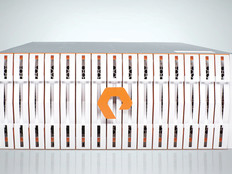From Virtual Desktops to the Cloud
Colleges and universities aim to make the transition from client virtualization to full-blown client computing in the cloud.
Joining the trend among many colleges and universities, New York's Orange County Community College has moved from static computer labs and kiosks to client virtualization. With this setup, students at both of the college's campuses can access the applications they need for class assignments and research, often saving money on expensive math and science applications.
The college made the move in summer 2009, outfitting student labs and a new library with Wyse Technology terminals, along with Wyse kiosks throughout campus. Both run the Wyse WSM management system, which streams the operating system and applications. The IT staff manages the system and has created a handful of images for the units so students can get the right set of applications for the classes they take, explains Kenneth Kempsey, director of user support and operations.
Even with the move to client virtualization, Kempsey knows that moving more deeply into cloud computing – beyond the college's use of tools like Google Docs – is inevitable.
"I can see a point where we might move client computing in that direction," he says. "It's just a matter of time, maturity and getting users used to the idea, but I think we'll get there."
Bob O'Donnell, vice president of clients and displays for research group IDC, agrees.
"It's a natural next step from client virtualization, because it provides the flexibility users need, and the customer service that organizations want to provide for users who no longer have one primary computer to work from, but several devices," O'Donnell says. "We'll get to the point where users will essentially log in to a Windows desktop in the cloud hosted through something like VMware, Citrix or Microsoft."
Realizing the Vision
Some colleges and universities are well on their way to achieving the move to cloud computing. The University of Utah's College of Engineering, for example, bypassed client virtualization altogether to adopt Lenovo's Secure Cloud Access Client, a solution that lets desktops, notebooks and other devices access applications in the cloud via a web browser. Students simply type in a URL from any device, input their user identification and password, and click the links for the applications they need.
"What's driven cloud computing for us has been the difficulty in getting students access to the engineering applications they need," says Doug Ressler, systems administrator at the engineering college. "They are very expensive, and students can't afford to put them on their own computers."
Before moving to the Lenovo Secure Cloud Access Client solution, Ressler and the rest of the IT team would routinely spend hours helping students connect to a terminal server and VPN connections.
"We had to go to class with them and teach them how to connect, which took a lot of time for the students and the IT staff," he says. "After spending a couple of years doing this at the beginning of each semester, we knew we had to find a better way."
Although client virtualization will probably be part of the IT infrastructure at some point, Ressler believes that the Secure Cloud Access Client solution is an important part of the overall desktop path for the college.
50%
The percentage of IT decision-makers who say business agility is their organization's primary reason for adopting cloud computing
SOURCE: Sand Hill Group
"With the SCA solution, I can pull together all of the cloud resources a given user or group needs and put them within a single web session, which is then available to our users anywhere in the world they happen to be and on any hardware platform, as long as they have broadband access," Ressler says.
Another reason for going the SCA route is security. Ressler's team is always concerned that unauthorized users might access engineering applications, so they wanted to keep such users behind a firewall. The Secure Cloud Access solution comes with its own set of protective mechanisms on the front end, which provides extra protection, so only authorized users for a given application have access to the cloud resource links.
Although the full implementation of the Lenovo Secure Access Cloud Client won't be rolled out until later this fall, many other departments in the university have expressed interest. The College of Law is likely the next candidate, but Ressler believes more departments will follow.
One Step at a Time
Client virtualization is just the first step toward client computing in the cloud. Along with the many client virtualization technologies available today, manufacturers such as Wyse Technology and Lenovo are introducing client computing models that incorporate virtualization and the cloud.
But the goal, true desktop as a service, is several years off, says Bob O'Donnell, vice president of clients and displays at IDC.
"The vision of being able to access a desktop in the cloud, where all of your applications and settings are housed, can be done today, but not to the scale that organizations need," he explains.
To get there means that all – not just some – of the applications users need are capable of being virtualized and stored in the cloud. That's not a reality today, O'Donnell says, because some software might need to be upgraded to a newer (and more expensive) version that will work in the cloud, and other software that was custom-written (like an enterprise resource planning system) may need to be replaced.
"It's just a matter of time, because that's what users want," he says. "The flexibility of being able to access your desktop on any device from any location is just too compelling."








